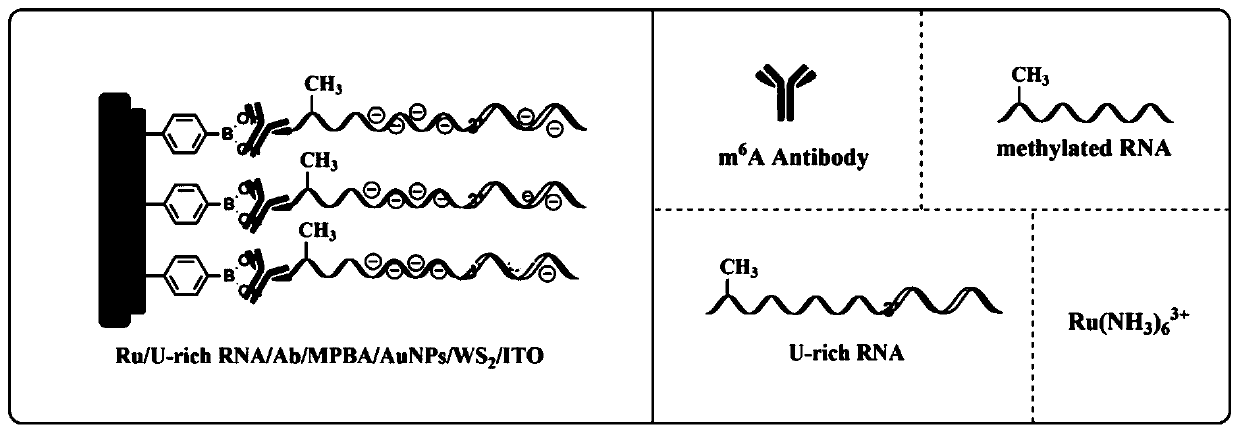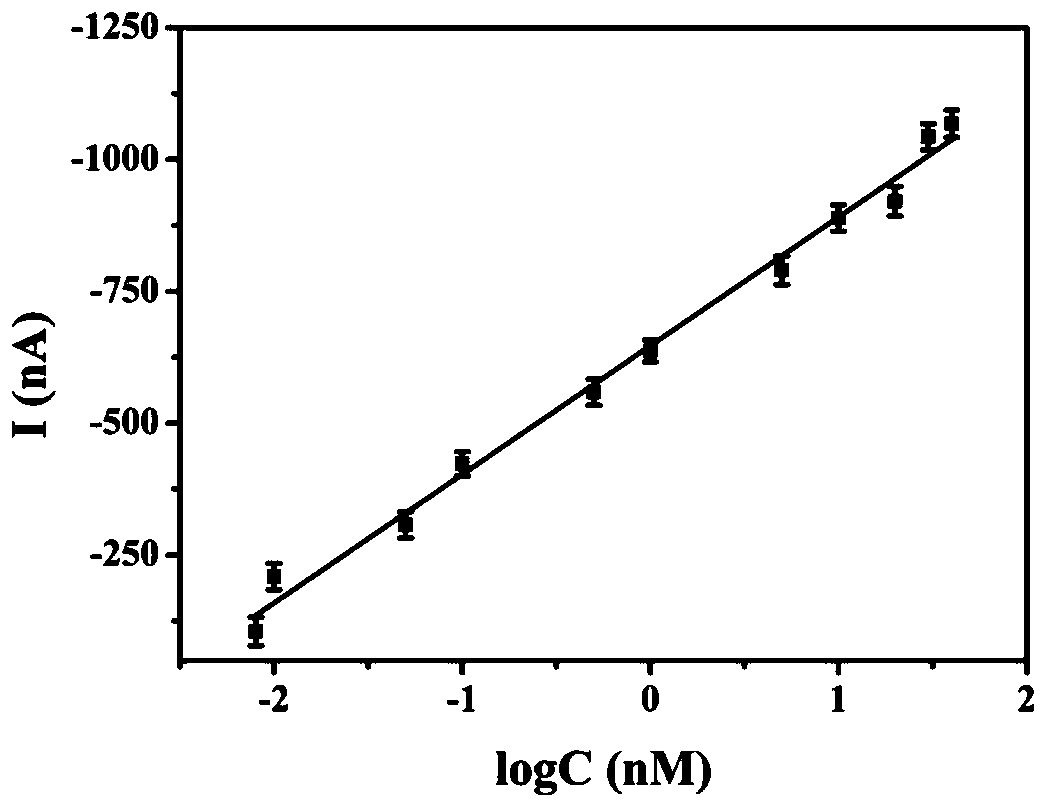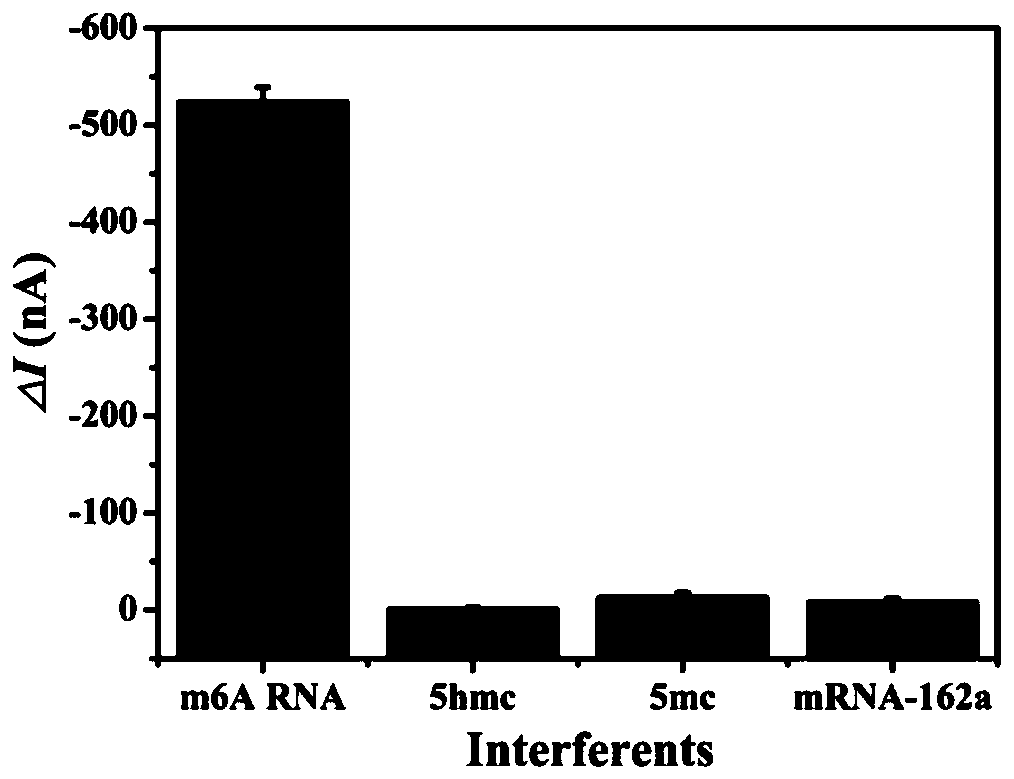Photoelectrochemical sensor for detecting methylated RNA and detection method thereof
A photoelectrochemical and sensor technology, applied in the direction of material electrochemical variables, scientific instruments, instruments, etc., can solve the problems of low detection sensitivity, cumbersome processing, and low specificity, and achieve high detection sensitivity, simple detection method, The effect of high detection selectivity
- Summary
- Abstract
- Description
- Claims
- Application Information
AI Technical Summary
Problems solved by technology
Method used
Image
Examples
preparation example Construction
[0044] (1) Preparation of tungsten sulfide dispersion: Weigh 10-20 mg of tungsten sulfide, add it into deionized water, and ultrasonically disperse for 1-3 hours to prepare a tungsten sulfide dispersion with a concentration of 0.4-5 mg / ml.
[0045] (2) ITO electrode pretreatment: divide the ITO conductive glass into 5×1cm 2 , and then ultrasonically cleaned with ethanol / NaOH mixture (volume ratio 1:1-1:6) for 30-60 minutes, and finally cleaned with acetone and secondary water for 30-60 minutes respectively, and dried at room temperature. stand-by.
[0046] (5) Fixation of tungsten sulfide: Add 25-76 μL of tungsten sulfide dispersion liquid dropwise to the surface of the pretreated ITO electrode, and dry it by infrared light irradiation. Then, wash the electrode with cleaning solution for 3-5 times. Blow dry with nitrogen. The prepared electrode is marked as WS 2 / ITO.
[0047] (4) Modification of nano-gold: Add 16-55 μL nano-gold solution to WS 2 / ITO electrode surface, ...
Embodiment 1
[0060] Example 1: Construction of a photoelectrochemical sensor for detecting methylated RNA
[0061] (1) Preparation of tungsten sulfide dispersion: Weigh tungsten sulfide and add it into deionized water, and ultrasonically disperse for 2 hours to prepare a tungsten sulfide dispersion with a concentration of 2.5 mg / ml.
[0062] (2) ITO electrode pretreatment: divide the ITO conductive glass into 5×1cm 2 , and then ultrasonically cleaned with ethanol / NaOH mixture (volume ratio 1:3) for 60 minutes, and finally cleaned with acetone and secondary water for 30 minutes respectively, and dried at room temperature for use.
[0063] (5) Fixation of tungsten sulfide: 50 μL of tungsten sulfide dispersion was added dropwise to the surface of the pretreated ITO electrode, and dried by infrared light irradiation. Then, wash the electrode with cleaning solution for 3-5 times. Blow dry with nitrogen. The prepared electrode is marked as WS 2 / ITO.
[0064] (4) Modification of nano-gold: ...
Embodiment 2
[0070] Embodiment 2: photoelectrochemical detection
[0071] The electrochemical workstation is used as the signal acquisition instrument, the 500W xenon lamp is used as the visible light source (installed with UV-filtering lens), Ru / U-rich RNA / Ab / MPBA / AuNPs / WS 2 The / ITO electrode is the working electrode, the saturated calomel electrode is the reference electrode, the platinum column electrode is the counter electrode, the 10mM Tris-HCl (pH 7.4) buffer solution containing 0.1M KCl is the detection solution, and the working voltage is -0.3V. Using i-t technology to detect the analyte, establish the relationship between photocurrent and methylated RNA concentration, the linear range is 0.008-30nM, and the calibration curve is I(nA)=-243.898logc-646.944 (R=0.9954) , the detection limit is 2.67pM ( figure 2 ).
PUM
 Login to View More
Login to View More Abstract
Description
Claims
Application Information
 Login to View More
Login to View More - R&D
- Intellectual Property
- Life Sciences
- Materials
- Tech Scout
- Unparalleled Data Quality
- Higher Quality Content
- 60% Fewer Hallucinations
Browse by: Latest US Patents, China's latest patents, Technical Efficacy Thesaurus, Application Domain, Technology Topic, Popular Technical Reports.
© 2025 PatSnap. All rights reserved.Legal|Privacy policy|Modern Slavery Act Transparency Statement|Sitemap|About US| Contact US: help@patsnap.com



